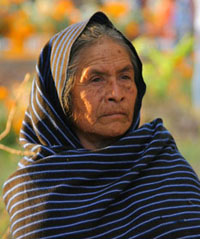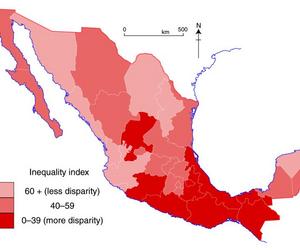Note: This article is an edited extract from chapter 29 of Geo-Mexico: the geography and dynamics of modern Mexico, by Richard Rhoda and Tony Burton (Sombrero Books, 2010). Reproduced by permission of the authors; all rights reserved.

Females comprise 51.3% of the Mexican population (there are 94.8 men for every 100 women). However, with isolated exceptions, Mexico has been a male-dominated society for a long time, and the spirit of machismo is still very strong in many parts of the country. Mexico has never had a female head of state and has had very few female cabinet members. The precise roles of women in Mexican society vary greatly from one region to another. The indigenous Zapotec community of Juchitán in Oaxaca is at one extreme. It functions as a matriarchal society where women play a much more important role than men in trading and decision-making. There are also vast differences across the country in terms of economic well-being. At one extreme, María Asunción Aramburuzabala is a billionaire who has proved that Mexican women can be incredibly successful in business; at the other, thousands of women face a daily struggle against starvation and violence in the home.
Overall, the situation is improving. More females are now enrolling in university courses, though the difference in rate between females and males is still pronounced. More women are seeking paid employment, and more are entering politics. About 20% of the senators in the 2006–2009 legislature are female, so their influence in national politics is increasing. On the other hand, at the local level, only 3.5% of 2006 municipal presidents were female.
Map: Gender Inequality

The percentage of the workforce that is female doubled from 17% in 1979 to about 40% in 2005. In that year, the active female workforce comprised 16.2 million women, whereas the male workforce numbered 26.0 million. However, it is important to remember that women perform far more unpaid, but socially vital, work in the home than men do.
The map shows gender inequality, using a composite gender inequality index based on the state rankings for three variables: difference in literacy rates between male and females, differences in rates of economic participation and the percentage of municipal leaders who are female.
The overall pattern of gender disparity is quite similar to the pattern for female quality of life, but there are some anomalies. Southern states are those where both the quality of life for females and the gender disparities are greatest. However, while females living in the three states comprising the Yucatán peninsula have a comparatively low quality of life, the gender disparities in those states are relatively low. On the other hand, while the quality of life in and around Mexico City is quite high for females, the level of disparities in central Mexico remains considerable.
Gender inequality is not an intangible aspect of life. Figures show that there are significant differences in the median wages of male and female employees in every subsection of the workforce with the exception of skilled technicians where females’ median wages are fractionally higher. For instance, the median wage for female teachers is 91.2% that for men; for professionals, 82.7%; and for industrial supervisors 66.9%. When levels of education are taken into account, female wage “discrimination” is even more pronounced in most occupations. With equal educational levels, female skilled technicians make 97.3% of what males make; teachers 97.6%; professionals 76.6%; and industrial supervisors only 68.4%.
Sources: please see Geo-Mexico for sources of statistics used in this article.
For more information about Geo-Mexico, please visit geo-mexico.com


